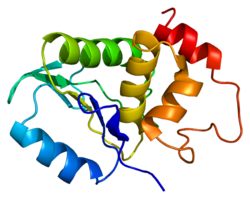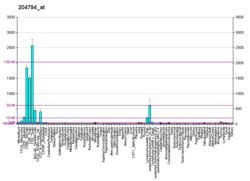Protein-coding gene in the species Homo sapiens
| DUSP2 |
|---|
 |
| Available structures |
|---|
| PDB | Ortholog search: PDBe RCSB |
|---|
|
|
| Identifiers |
|---|
| Aliases | DUSP2, PAC-1, PAC1, dual specificity phosphatase 2 |
|---|
| External IDs | OMIM: 603068; MGI: 101911; HomoloGene: 3255; GeneCards: DUSP2; OMA:DUSP2 - orthologs |
|---|
| Gene location (Human) |
|---|
 | | Chr. | Chromosome 2 (human)[1] |
|---|
| | Band | 2q11.2 | Start | 96,143,169 bp[1] |
|---|
| End | 96,145,440 bp[1] |
|---|
|
| Gene location (Mouse) |
|---|
 | | Chr. | Chromosome 2 (mouse)[2] |
|---|
| | Band | 2|2 F1 | Start | 127,178,079 bp[2] |
|---|
| End | 127,180,296 bp[2] |
|---|
|
| RNA expression pattern |
|---|
| Bgee | | Human | Mouse (ortholog) |
|---|
| Top expressed in | - seminal vesicula
- granulocyte
- lymph node
- mucosa of urinary bladder
- monocyte
- spleen
- testicle
- gallbladder
- bone marrow cells
- appendix
|
| | Top expressed in | - mesenteric lymph nodes
- thymus
- spleen
- trachea
- blood
- granulocyte
- embryo
- lip
- tibiofemoral joint
- bone marrow
|
| | More reference expression data |
|
|---|
| BioGPS |  | | More reference expression data |
|
|---|
|
| Gene ontology |
|---|
| Molecular function | - protein tyrosine phosphatase activity
- phosphatase activity
- MAP kinase tyrosine/serine/threonine phosphatase activity
- protein tyrosine/threonine phosphatase activity
- protein binding
- phosphoprotein phosphatase activity
- hydrolase activity
- protein tyrosine/serine/threonine phosphatase activity
- mitogen-activated protein kinase binding
| | Cellular component | - nucleus
- nuclear membrane
- cytoplasm
| | Biological process | - protein dephosphorylation
- endoderm formation
- dephosphorylation
- peptidyl-tyrosine dephosphorylation
| | Sources:Amigo / QuickGO |
|
|
| Wikidata |
| View/Edit Human | View/Edit Mouse |
|
Dual specificity protein phosphatase 2 is an enzyme that in humans is encoded by the DUSP2 gene.[5][6][7][8]
The protein encoded by this gene is a member of the dual specificity protein phosphatase subfamily. These phosphatases inactivate their target kinases by dephosphorylating both the phosphoserine/threonine and phosphotyrosine residues. They negatively regulate members of the mitogen-activated protein (MAP) kinase superfamily (MAPK/ERK, SAPK/JNK, p38), which are associated with cellular proliferation and differentiation.
Different members of the family of dual specificity phosphatases show distinct substrate specificities for various MAP kinases, different tissue distribution and subcellular localization, and different modes of inducibility of their expression by extracellular stimuli. This gene product inactivates ERK1 and ERK2, is predominantly expressed in hematopoietic tissues, and is localized in the nucleus.[8]
References
- ^ a b c GRCh38: Ensembl release 89: ENSG00000158050 – Ensembl, May 2017
- ^ a b c GRCm38: Ensembl release 89: ENSMUSG00000027368 – Ensembl, May 2017
- ^ "Human PubMed Reference:". National Center for Biotechnology Information, U.S. National Library of Medicine.
- ^ "Mouse PubMed Reference:". National Center for Biotechnology Information, U.S. National Library of Medicine.
- ^ Martell KJ, Kwak S, Hakes DJ, Dixon JE, Trent JM (Jan 1995). "Chromosomal localization of four human VH1-like protein-tyrosine phosphatases" (PDF). Genomics. 22 (2): 462–4. doi:10.1006/geno.1994.1411. hdl:2027.42/31442. PMID 7806236.
- ^ Yi H, Morton CC, Weremowicz S, McBride OW, Kelly K (Dec 1995). "Genomic organization and chromosomal localization of the DUSP2 gene, encoding a MAP kinase phosphatase, to human 2p11.2-q11". Genomics. 28 (1): 92–6. doi:10.1006/geno.1995.1110. PMID 7590752.
- ^ Yin Y, Liu YX, Jin YJ, Hall EJ, Barrett JC (Apr 2003). "PAC1 phosphatase is a transcription target of p53 in signalling apoptosis and growth suppression". Nature. 422 (6931): 527–31. Bibcode:2003Natur.422..527Y. doi:10.1038/nature01519. PMID 12673251. S2CID 4363302.
- ^ a b "Entrez Gene: DUSP2 dual specificity phosphatase 2".
Further reading
- Wu J, Jin YJ, Calaf GM, et al. (2007). "PAC1 is a direct transcription target of E2F-1 in apoptotic signaling". Oncogene. 26 (45): 6526–35. doi:10.1038/sj.onc.1210484. PMID 17471234.
- Zhang Q, Muller M, Chen CH, et al. (2006). "New insights into the catalytic activation of the MAPK phosphatase PAC-1 induced by its substrate MAPK ERK2 binding". J. Mol. Biol. 354 (4): 777–88. doi:10.1016/j.jmb.2005.10.006. PMID 16288922.
- Gerhard DS, Wagner L, Feingold EA, et al. (2004). "The status, quality, and expansion of the NIH full-length cDNA project: the Mammalian Gene Collection (MGC)". Genome Res. 14 (10B): 2121–7. doi:10.1101/gr.2596504. PMC 528928. PMID 15489334.
- Kothapalli R, Yoder SJ, Kusmartseva I, Loughran TP (2004). "Characterization of a variant of PAC-1 in large granular lymphocyte leukemia". Protein Expr. Purif. 32 (1): 52–60. doi:10.1016/S1046-5928(03)00237-7. PMID 14680939.
- Zhang Y, Guan DL, Xia CQ, et al. (2004). "Relationship between the expression levels of CD61, CD63, and PAC-1 on platelet surface in peripheral blood and the transplanted kidney function". Transplant. Proc. 35 (4): 1360–3. doi:10.1016/S0041-1345(03)00469-X. PMID 12826159.
- Farooq A, Plotnikova O, Chaturvedi G, et al. (2003). "Solution structure of the MAPK phosphatase PAC-1 catalytic domain. Insights into substrate-induced enzymatic activation of MKP". Structure. 11 (2): 155–64. doi:10.1016/S0969-2126(02)00943-7. PMID 12575935.
- Strausberg RL, Feingold EA, Grouse LH, et al. (2003). "Generation and initial analysis of more than 15,000 full-length human and mouse cDNA sequences". Proc. Natl. Acad. Sci. U.S.A. 99 (26): 16899–903. Bibcode:2002PNAS...9916899M. doi:10.1073/pnas.242603899. PMC 139241. PMID 12477932.
- Ward Y, Gupta S, Jensen P, et al. (1994). "Control of MAP kinase activation by the mitogen-induced threonine/tyrosine phosphatase PAC1". Nature. 367 (6464): 651–4. Bibcode:1994Natur.367..651W. doi:10.1038/367651a0. PMID 8107850. S2CID 4257340.
- Rohan PJ, Davis P, Moskaluk CA, et al. (1993). "PAC-1: a mitogen-induced nuclear protein tyrosine phosphatase". Science. 259 (5102): 1763–6. Bibcode:1993Sci...259.1763R. doi:10.1126/science.7681221. PMID 7681221.
- Raingeaud J, Gupta S, Rogers JS, et al. (1995). "Pro-inflammatory cytokines and environmental stress cause p38 mitogen-activated protein kinase activation by dual phosphorylation on tyrosine and threonine". J. Biol. Chem. 270 (13): 7420–6. doi:10.1074/jbc.270.13.7420. PMID 7535770.
 | This article on a gene on human chromosome 2 is a stub. You can help Wikipedia by expanding it. |

 1m3g: SOLUTION STRUCTURE OF THE CATALYTIC DOMAIN OF MAPK PHOSPHATASE PAC-1: INSIGHTS INTO SUBSTRATE-INDUCED ENZYMATIC ACTIVATION
1m3g: SOLUTION STRUCTURE OF THE CATALYTIC DOMAIN OF MAPK PHOSPHATASE PAC-1: INSIGHTS INTO SUBSTRATE-INDUCED ENZYMATIC ACTIVATION




















